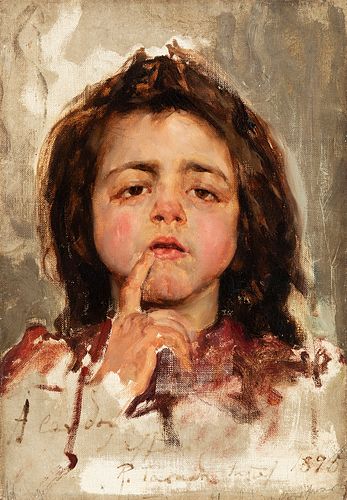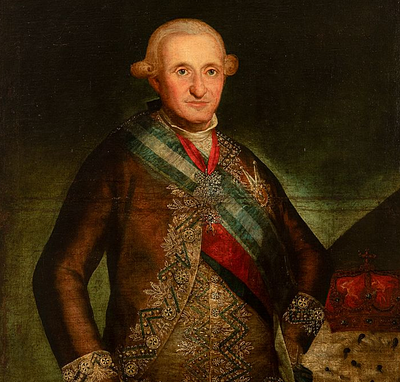School of IGNACIO PINAZO CAMARLENCH (Valencia, 1849 - Godella, Valencia, 1916)"Portrait of a girl, 1895.Oil on canvas.
Lot 60
About Seller
Setdart Auction House
Carrer Aragó 346
Barcelona
Spain
Setdart Subastas was born in 2004 and is currently the first online art auction in Spain with solidity, prestige and reliability guaranteed by our more than 60,000 users. Setdart has a young, dynamic and enterprising team ready to successfully manage the purchase and sale of art works through custom...Read more
Estimate:
EUR€2,500 - EUR€3,000
$2,577.32 - $3,092.78
Absentee vs Live bid
Two ways to bid:
- Leave a max absentee bid and the platform will bid on your behalf up to your maximum bid during the live auction.
- Bid live during the auction and your bids will be submitted real-time to the auctioneer.
Bid Increments
| Price | Bid Increment |
|---|---|
| EUR€0 | EUR€10 |
| EUR€200 | EUR€25 |
| EUR€500 | EUR€50 |
| EUR€1,000 | EUR€100 |
| EUR€3,000 | EUR€200 |
| EUR€5,000 | EUR€500 |
| EUR€10,000 | EUR€1,000 |
| EUR€20,000 | EUR€2,000 |
| EUR€50,000 | EUR€5,000 |
About Auction
By Setdart Auction House
Sep 22, 2021
Set Reminder
2021-09-22 09:30:00
2021-09-22 09:30:00
America/New_York
Bidsquare
Bidsquare : 22nd September - ARAS JÁUREGUI Private Collection - Old Masters, 19th & 20th Century
https://www.bidsquare.com/auctions/setdart-auction-house/22nd-september---aras-j-uregui-private-collection---old-masters-19th-20th-century-7427
ARAS JÁUREGUI Private Collection - Old Masters, 19th & 20th Century Setdart Auction House sofia@setdart.com
ARAS JÁUREGUI Private Collection - Old Masters, 19th & 20th Century Setdart Auction House sofia@setdart.com
- Lot Description
School of IGNACIO PINAZO CAMARLENCH (Valencia, 1849 - Godella, Valencia, 1916). "Portrait of a girl, 1895. Oil on canvas. With dedication and traces of signature. Size: 45 x 31 cm; 53 x 40 cm (frame). The representation of children was a common theme in Pinazo's painting, who from 1876, coinciding with his second stay in Rome, made children the protagonists of many of his works. In this particular work we can see the almost sketchy portrait of a girl, notable for her spontaneous gestures. This characteristic was highly valued by the Valencian artist in the conception of his works that reflected the world of children. Born into a humble family, Pinazo was obliged from an early age to contribute to the upkeep of his home through various occupations. He had only completed the eighth year at school when his mother died of cholera, so he was soon employed in various trades, including silversmith, tile decorator, baker, gilder and fan painter. After his father's death he moved in with his grandfather and in 1864 he entered the San Carlos Academy of Fine Arts, where he was a pupil of José Fernández Olmos. During this period he earned his living as a milliner. He began his artistic training at the age of twenty-one, achieving his first success three years later in Barcelona. In 1871 he took part for the first time in the National Exhibition of Fine Arts. He was in Rome twice, the first time thanks to the sale of a painting in 1873, and the second time on a scholarship between 1876 and 1881. It was there that he began his major historical productions, far removed from the conventions of the genre. In his first period he developed an academicist style, but from 1874 he began to paint in a more intimate, impressionistic style. When he returned to Valencia he abandoned historical themes and instead began to paint family subjects, nudes and scenes from everyday life. He is now considered a precursor, in both subject matter and style, of Joaquín Sorolla and Francisco Domingo. In 1884 Pinazo left Valencia temporarily due to a cholera epidemic, moving into the house that the banker José Jaumandreu owned in Bétera. From his return that same year until 1886 he taught at the Valencia School of Fine Arts. During these years he received numerous commissions from the Valencian aristocracy, and his clients included prominent figures such as the Marchioness of Benicarló. Pinazo exhibited his works at the National Exhibitions of Fine Arts in Madrid, winning a silver medal in 1881 and 1885 and a gold medal in 1897 and 1899. In 1896 he was appointed a member of the Academy of San Carlos, and in 1906 he became a member of the Academy of San Fernando in Madrid. In 1900 he was involved in the decoration of the staircase of the palace of Don José Ayora, together with Antonio Fillol, Peris Brell, Ricardo Verde and Luis Beüt. During these years he was awarded a royal medal and in 1912 the city of Valencia dedicated a street to him. After his death in 1916, a series of commemorative events were held to commemorate his life and work. Pinazo is currently represented in the Prado Museum, the MACBA in Barcelona, the Museum and Circle of Fine Arts in Valencia, his House-Museum in Godella and the Valencian Provincial Council, as well as in various important private collections.
- Shipping Info
-
In-house shipping available. Please inquire at admin@setdart.com.
-
- Buyer's Premium



 EUR
EUR CAD
CAD AUD
AUD GBP
GBP MXN
MXN HKD
HKD CNY
CNY MYR
MYR SEK
SEK SGD
SGD CHF
CHF THB
THB

















